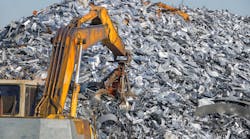By Erich Lawson, online marketing manager with Compactor Management Company
Manufacturing waste is commonly overlooked by business owners, but its unchecked presence can have a substantial financial impact on a company. Whether it's transportation waste, inventory waste, or the production of defective products, waste can accumulate across various areas within the organization.
Let's delve into the diverse types of manufacturing waste and provide insights into effective waste-disposal methods. Additionally, let's explore the concept of lean manufacturing and how it can proactively address wastage issues while enhancing overall manufacturing productivity.
1. Overproduction: Producing more than necessary disrupts the material flow, degrades quality, and reduces productivity. Implementing a just-in-time (JIT) production strategies helps by manufacturing items only when needed, avoiding excessive lead times and storage costs.
2. Transport: Unnecessary movement and handling during transportation can damage products and decrease their quality. Optimizing the production-facility layout reduces excessive transport, ensuring smooth operations and closer proximity between workcenters.
3. Unnecessary/excess motion: Excessive worker movements, such as searching for tools or materials, cause delays and potential safety hazards. Analyzing operation steps and minimizing worker motion improves efficiency and safety.
4. Unnecessary inventory: Overproducing and waiting result in work-in-process (WIP) items and excess inventory, incurring significant costs. Seamless workflow, JIT strategies, and reduced inventory levels enhance productivity, lead time, and problem detection.
5. Waiting: Idle time for products or WIP items slows down production. Poor material flow, long cycle times, and distant workcenters contribute to waiting for waste. Connecting processes efficiently minimizes waiting time and maximizes output.
6. Over-processing: Redundant activities that add no value, such as excessive inspections or documentation, increase costs. Using cost-effective tools and investing in flexible equipment saves money and improves efficiency.
7. Defects: Defects incur significant costs through rework, scrap, inventory quarantine, and rescheduling. Employee involvement and continuous process improvement helps reduce defects, enhance product quality, and reduce waste.
By addressing these types of manufacturing waste, businesses can enhance overall productivity.
Now let's consider ways to reduce manufacturing wastes
1. Implementing lean manufacturing principles: Waste can accumulate in various ways during the manufacturing process, some of which may be difficult to detect. However, by implementing lean methodology, businesses can effectively identify and address waste without compromising productivity.
In lean manufacturing, customer needs are the defining factor at every stage, with the goal of identifying and eliminating tasks that do not add value to the customer or the process. The methodology focuses on principles such as automation, visual control, flexibility, waste reduction, supplier-relationship management, and continuous improvement.
Unlike other methods, lean not only reduces waste but also addresses the root cause and empowers teams to solve and prevent problems. By adopting lean methodology, businesses can optimize productivity, enhance customer satisfaction, and achieve sustainable growth.
2. Efficient inventory management: Effective control over materials used in the manufacturing process and maintaining optimal inventory levels (including raw materials, work-in-progress, and finished goods) can significantly reduce manufacturing waste and mitigate risks of loss, decay and damage.
To minimize waste generation, it is essential to reduce excess raw-material stock and limit the use of hazardous materials. Ordering only the necessary quantity of materials based on production requirements and customer demand for a specific period is crucial.
Avoiding unnecessary purchases and carefully analyzing past sales data enables accurate estimation of production needs. Identifying best-selling products and less profitable items empowers businesses to focus production efforts on the right items, optimizing resource utilization and minimizing waste.
3. Recover, reuse, recycle: Efficient waste management is crucial for businesses, and there are various techniques to recover waste from both onsite and offsite locations. Employing methods like electrolysis, filtration, reverse osmosis, and centrifugation enables effective waste recovery. Recycling materials such as paper, plastic, and metal is a popular choice, while hazardous materials should be avoided in recycling due to limited environmental benefits.
Industrial waste-management equipment, such as baler machines, compactors, and shredders, play a critical role in reducing waste by condensing materials like asphalt, wood, rubber, and plastics. Proper waste-sorting ensures recyclable items reach the right destinations, and designating someone to monitor waste bins facilitates viable solutions for waste reduction, reuse or recycling. It's important to remember that what may be waste for one business could be a valuable resource for another, making waste-exchange programs a beneficial option.
4. Waste-reduction audit: Conducting audits offers valuable insights into equipment usage and opportunities for improvement. By targeting how equipment is used, audits can identify increased wear on components that are already prone to breakdowns. Implementing appropriate measures, such as protective plates, can extend the lifespan of replaceable parts and reduce costs over time.
Furthermore, the way employees handle machinery plays a crucial role. Ongoing training ensures that everyone operates equipment correctly, as deviating from recommended usage can cause machinery to work harder than intended and increase wear on delicate components. Employee turnover can also impact productivity, particularly if there is a shortage of qualified workers capable of operating heavy machinery. In such cases, a year with high turnover could significantly affect productivity if machinery breaks down due to improper usage. By prioritizing audits and employee training, businesses can optimize equipment performance, minimize breakdowns, and enhance overall productivity.
5. Implement preventive maintenance: Don't wait until machinery breaks down to seek service, as that leads to wasted time and unnecessary costs. Stay proactive with preventative maintenance by following a clear, consistent schedule. Utilize inventory apps to receive alerts for important dates like expiring warranties. While wear-and-tear is expected, prioritizing preventative maintenance helps maximize equipment lifespan, benefiting both your profits and the environment.


